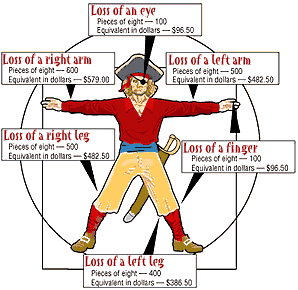By present-day standards, a pirate ship would be considered a model of workplace democracy. Pirate crews were based on "constitutions" that spelled out the rights and responsibility of its crew. These constitutions exhibited many, if not all, of WorldBlu's 10 Principles of Organizational Democracy,
- Purpose and Vision. A pirate crew came together for one single purpose: profit. This, according to Leeson, drove every other aspect of pirate crew organization and governance.
- Transparency. As mentioned, pirate crews were bound by a constitution that spelled out the rights and responsibility of its crew.
- Dialogue + Listening. Crew members had a say in the running of the ship (except in battle, when the Captain reigned supreme). They could at any point vote out the Captain or Quartermaster and elect another. This kept the conversation going.
- Fairness + Dignity. Every crew member had an equal vote. Pirate constitutions also "created what economists call 'common knowledge' among crew members… this enabled pirates to coordinate on a common response to quartermaster abuse, which was to depose him and elect a new one." (pp 78) Injured members got extra compensation according to a scheduled spelled out in the ship's constitution, " for the loss of a right arm, 600 pieces of eight… " (pp 59)
- Accountability. The Captain's and Quartermaster's responsibilities and limitations were spelled out in the ship's constitution.
- Individual + Collective. Crew members were "valued for their individual contribution," with specific bonuses paid out for extraordinary accomplishments. "Those who behaved courageously and performed any deed of extraordinary valour, or captured a ship, should be rewarded out of the common plunder." (pp 72)
- Choice. The one-man-one-vote rule gave these crews a "meaningful choice."
- Integrity. Integrity is the name of the game, and democratic companies have a lot of it. They understand that freedom takes discipline and also doing what is morally and ethically right.
- Decentralization. As opposed to commercial ships, which were run as a dictatorship, pirate ships split executive powers between the Captain and the Quartermaster.
- Reflection + Evaluation. Pirates moved from one crew to another at the end of each "account." In so doing, they shared best practices and learned from each experience since each crew member had a say in a new crew's constitution.
 (See:
(See: